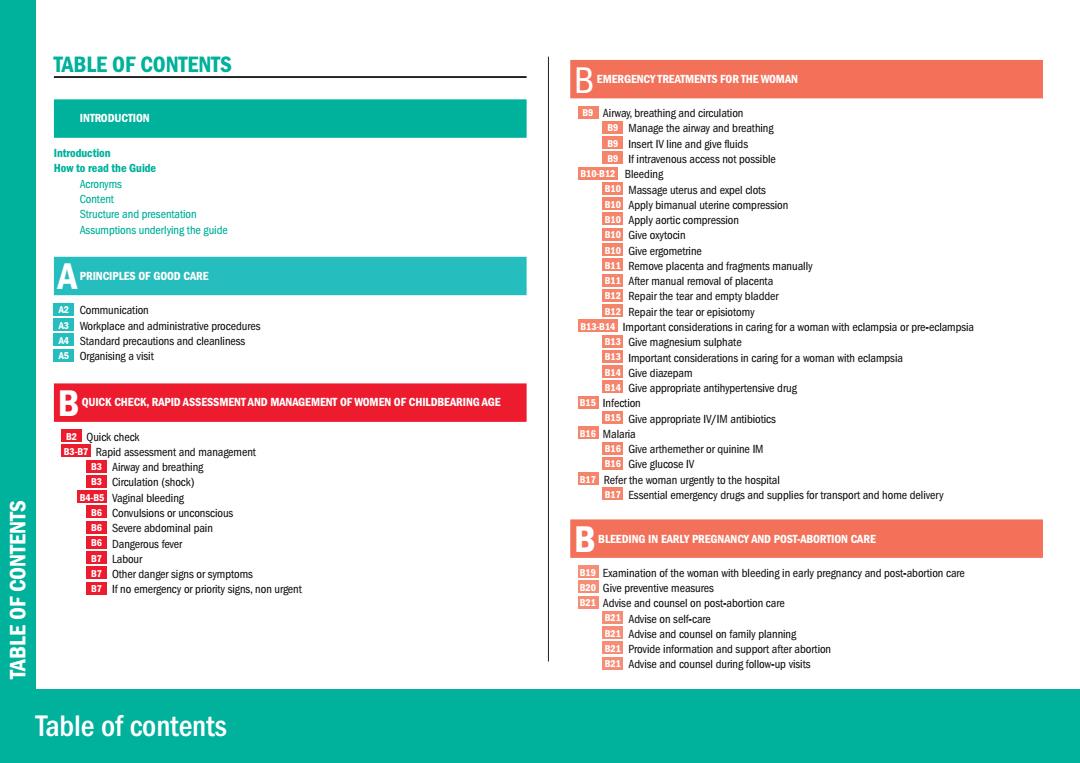正在加载图片...

TABLE OF CONTENTS B EMERGENCY TREATMENTS FOR THE WOMAN INTRODUCTION B Airway,breathing and circulation Manage the airway and breathing B Insert IV line and give fluids Introduction If intravenous access not possible How to read the Guide E1002 Bleeding Acronyms Massage uterus and expel clots Content Apply bimanual uterine compression Structure and presentation B10 Apply aortic compression Assumptions underlying the guide B10 Give oxytocin B10 Give ergometrine Remove placenta and fragments manually PRINCIPLES OF GOOD CARE After manual removal of placenta Repair the tear and empty bladder A2: Communication Repair the tear or episiotomy A好 Workplace and administrative procedures Important considerations in caring for a woman with eclampsia or pre-eclampsia M Standard precautions and cleanliness Eh Give magnesium sulphate 5Organising a visit Important considerations in caring for a woman with eclampsia B Give diazepam Give appropriate antihypertensive drug QUICK CHECK.RAPID ASSESSMENT AND MANAGEMENT OF WOMEN OF CHILDBEARING AGE 15Infection Give appropriate IV/IM antibiotics 2 Quick check B16 Malaria B6-B Rapid assessment and management GGive arthemether or quinine IM Bs Airway and breathing ENG Give glucose IV B3 Circulation(shock) Refer the woman urgently to the hospital B4-85 Vaginal bleeding Essential emergency drugs and supplies for transport and home delivery B6 Corulsions or unconscious SIN3INOO 86 Severe abdominal pain B6 Dangerous fever BLEEDING IN EARLY PREGNANCY AND POST-ABORTION CARE B7 Labour Other danger signs or symptoms Examination of the woman with bleeding in early pregnancy and post-abortion care If no emergency or priority signs,non urgent 20 Give preventive measures Advise and counsel on post-abortion care Advise on self-care Advise and counsel on family planning B21 Provide information and support after abortion Advise and counsel during follow-up visits Table of contentsTable of contents TABLE OF CONTENTS TABLE OF CONTENTS A INTRODUCTION Introduction How to read the Guide Acronyms Content Structure and presentation Assumptions underlying the guide A PRINCIPLES OF GOOD CARE A2 Communication A3 Workplace and administrative procedures A4 Standard precautions and cleanliness A5 Organising a visit B QUICK CHECK, RAPID ASSESSMENT AND MANAGEMENT OF WOMEN OF CHILDBEARING AGE B2 Quick check B3-B7 Rapid assessment and management B3 Airway and breathing B3 Circulation (shock) B4-B5 Vaginal bleeding B6 Convulsions or unconscious B6 Severe abdominal pain B6 Dangerous fever B7 Labour B7 Other danger signs or symptoms B7 If no emergency or priority signs, non urgent BEMERGENCY TREATMENTS FOR THE WOMAN B9 Airway, breathing and circulation B9 Manage the airway and breathing B9 Insert IV line and give fluids B9 If intravenous access not possible B10-B12 Bleeding B10 Massage uterus and expel clots B10 Apply bimanual uterine compression B10 Apply aortic compression B10 Give oxytocin B10 Give ergometrine B11 Remove placenta and fragments manually B11 After manual removal of placenta B12 Repair the tear and empty bladder B12 Repair the tear or episiotomy B13-B14 Important considerations in caring for a woman with eclampsia or pre-eclampsia B13 Give magnesium sulphate B13 Important considerations in caring for a woman with eclampsia B14 Give diazepam B14 Give appropriate antihypertensive drug B15 Infection B15 Give appropriate IV/IM antibiotics B16 Malaria B16 Give arthemether or quinine IM B16 Give glucose IV B17 Refer the woman urgently to the hospital B17 Essential emergency drugs and supplies for transport and home delivery B BLEEDING IN EARLY PREGNANCY AND POST-ABORTION CARE B19 Examination of the woman with bleeding in early pregnancy and post-abortion care B20 Give preventive measures B21 Advise and counsel on post-abortion care B21 Advise on self-care B21 Advise and counsel on family planning B21 Provide information and support after abortion B21 Advise and counsel during follow-up visits